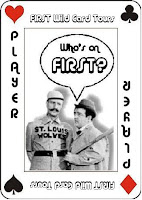 It is time for a FIRST Wild Card Tour book review! If you wish to join the FIRST blog alliance, just click the button. We are a group of reviewers who tour Christian books. A Wild Card post includes a brief bio of the author and a full chapter from each book toured. The reason it is called a FIRST Wild Card Tour is that you never know if the book will be fiction, non~fiction, for young, or for old…or for somewhere in between! Enjoy your free peek into the book!
It is time for a FIRST Wild Card Tour book review! If you wish to join the FIRST blog alliance, just click the button. We are a group of reviewers who tour Christian books. A Wild Card post includes a brief bio of the author and a full chapter from each book toured. The reason it is called a FIRST Wild Card Tour is that you never know if the book will be fiction, non~fiction, for young, or for old…or for somewhere in between! Enjoy your free peek into the book!
You never know when I might play a wild card on you!
Forces & Motion: From High-speed Jets to Wind-up Toys
***Special thanks to Robert Parrish of New Leaf Publishing Group for sending me a review copy.***
 Tom DeRosa left seminary and the church thinking he was throwing away his faith, but in reality he found a new religion: evolution. In 1978, Tom accepted Jesus Christ as Lord of his life. Soon after he studied biblical creation at Coral Ridge Presbyterian Church and came to the conclusion that a lack of knowledge of the biblical account of creation is greatly responsible for keeping many people from Christ. His commitment to breaking down those barriers is what led Tom to form Creation Studies Institute in 1988.
Tom DeRosa left seminary and the church thinking he was throwing away his faith, but in reality he found a new religion: evolution. In 1978, Tom accepted Jesus Christ as Lord of his life. Soon after he studied biblical creation at Coral Ridge Presbyterian Church and came to the conclusion that a lack of knowledge of the biblical account of creation is greatly responsible for keeping many people from Christ. His commitment to breaking down those barriers is what led Tom to form Creation Studies Institute in 1988.
 Carolyn Reeves, Ph.D. and her husband make their home in Oxford, Mississippi where they are active members of North Oxford Baptist Church. Carolyn retired after a 30-year career as a science teacher, finished a doctoral degree in science education, and began a new venture as a writer and an educational consultant.
Carolyn Reeves, Ph.D. and her husband make their home in Oxford, Mississippi where they are active members of North Oxford Baptist Church. Carolyn retired after a 30-year career as a science teacher, finished a doctoral degree in science education, and began a new venture as a writer and an educational consultant.
Product Details for the main book:
List Price: $ 12.99
Reading level: Ages 9-12
Paperback: 88 pages
Publisher: New Leaf Publishing Group/Master Books (January 16, 2009)
Language: English
ISBN-10: 0890515395
ISBN-13: 978-0890515396
Product Details for the student journal:
List Price: $ 4.99
Reading level: Ages 9-12
Paperback: 48 pages
Publisher: New Leaf Publishing Group; Student edition (January 16, 2009)
Language: English
ISBN-10: 0890515409
ISBN-13: 978-0890515402
Product Details for the teacher’s guide:
List Price: $ 4.99
Paperback: 48 pages
Publisher: New Leaf Publishing Group; Tch edition (January 16, 2009)
Language: English
ISBN-10: 0890515417
ISBN-13: 978-0890515419
AND NOW…THE FIRST CHAPTER:
Forces & Motion
From High-speed Jets to Wind-up Toys
By Tom DeRosa & Carolyn Reeves
Investigation #1: Wind-up Walking Toys, Speed, Time, and Distance
Think about this. Many people still consider “Bullet” Bob Hayes to be the world’s fastest runner. In the 1964 Tokyo Olympics, he was part of a 4 X 100 relay race. He was already running when he took the baton. He completed his 100 meters of the relay in 8.6 seconds. He also ran the 100-meter dash in 10.05 seconds. In this race, he started from a still position. Four years later at the Mexico City Olympics, James Hines ran an official time in the 100-meter dash that was less than 10.0 seconds for the first time ever. His record stood for several more years, but Bullet Bob’s relay race time will be a hard record to break.
These very fast runners were moving an average of about ten meters every second. Use a meter stick to mark off ten meters and make a prediction of how many meters you think you could run each second. Would you like to be able to figure out how many meters you can run in one second?
We can calculate the speed of a moving object by testing wind-up toys. How far a wind-up toy moves can be measured with a ruler. How long it takes the toy to move a certain distance can be measured with a watch. These two numbers can be used to calculate its speed.
The Investigative Problems:
How can we determine the speed and motion of a wind-up talking toy?
How can this be shown on a graph?
Gather These Things:
Walking toy
Chart
Pencil
Clock with second hand
Toothpicks
Metric ruler (with each cm divided into tenths)
Procedure & Observations
For these measurements, you will need a metric ruler where each centimeter is divided into tenths. Look carefully at the markings on the ruler. Notice there is a long line by each number. There are shorter lines following each number. The short lines are written as decimal numbers. Measure the line to the right by putting the zero mark of the ruler at the beginning of the line. The correct answer is found by writing the last whole number, a decimal, and the number of short marks following the number. The abbreviation “cm” is written after these numbers. Did you get 15.3 cm for your answer? Work with a partner. Each of you should draw two or three more lines. Measure each other’s lines. Check each other’s answers.
Lay the ruler out in front of you. Wind up the walking toy next to the ruler and measure how far it walks in ten seconds. Record. Calculate its average speed by dividing the total distance it walked in centimeters by ten seconds. Write your number answer followed by cm/s. This is read “centimeters per second.”
Measure how long it takes for the wind-up toy to walk one meter. Record. If it doesn’t make it that far, record how far it walked and the time it walked. Calculate its average speed by dividing the distance it walked by the time. The speed will be in m/s (meters per second) if it walks as far as a meter. If you measure the distance in cm, your answer will be in cm/s.
Go back to the starting point. Wind up the toy again. This time lay down a toothpick next to the ruler every time the instructor calls out a five-second interval. Record for 30 seconds. Measure the distances between toothpicks and record in the chart below.
Graph the results of distance versus time. Your teacher will show you how to put this information in the graph. Does your graph make a straight line or a curved line? Try to think of a reason for this.
Did your walking toy start out fast and then get slower until it stopped, or did it keep walking at the same speed all the way?
Race your walking toy with someone else’s. Which one was the fastest?
The Science Stuff
The motion of an object can be described by changes in its position, by its direction, and by its speed. Speed can be calculated by measuring the distance an object moves and the time it takes to move that distance. Divide the distance by the time to get the speed.
The distance traveled equals the object’s speed multiplied by the time traveled. The same units of time must be used. For example, if a toy travels 50 cm/minute and it travels fro a total of two minutes, it has traveled a total of 100 cm. The calculations would be 50 cm/min X 2 min = 100 cm. Minutes would cancel out, leaving cm as part of your answer.
Different aspects of motion can be shown on a graph. If the speed of the walking toy stayed the same, the graph line will be straight, but if your walking toy slowed down, the graph line will be a curve. Remember, the source of energy for walking toys is a wind-up spring. A tight spring may provide more energy than a loose spring.
Scientific measurements are taking in metric units. The correct abbreviation for centimeter is cm; for meter, it is m. the correct abbreviation for centimeters per second is
Cm/s; for meters per second, m/s.
1 centimeter (cm) = 1/100 meter
1 meter (m) = 100 centimeters
1 kilometer (km) = 1000 meters
Dig Deeper
See if you can use the Internet or some reference books to find the runners who have run at official speeds of ten meters per second or greater. (There won’t be many.)
Do additional research to find some more world records for swimming, skating, bicycling, or other sports.
Use the Internet or some reference books to find the top speeds of several animals. Did you find any that you could outrun? What is the difference in how humans run and how certain animals run.
(If you choose one of these projects, use a creative way to display your findings.)
Making Connections
Sometimes a highway patrol officer will stop a car for speeding, and the driver will insist that the car was traveling within the speed limit. Is it possible that the car’s speedometer is not accurate? Mile markers along the highway and a watch can tell if your car’s speedometer is accurate. To do that, have the driver hold the car’s speed at 60 miles/hour. Start timing with a watch that has a second hand as the car reaches a mile marker. Stop timing as the car reaches the next mile marker. The speedometer is accurate if the car travels one mile in 60 seconds. One mile/minute is the same as 60 miles/hour. You can also calculate the speed of your car by dividing the distance of one mile by the time it takes the car to travel from one mile marker to another.
Suppose you are traveling in a car wit the cruise control set at 65 miles per hour and your driver drives for two hours without stopping. Multiply the speed by two hours to see how many miles you have traveled in two hours, as: 65 mi/hr X 2 hr = 130 miles.
What Did You Learn?
What two things do you need to know in order to calculate speed?
What is the formula for calculating speed?
How would a line graph of the speed of a runner look when the runner goes slower and slower? Or faster and faster? Or maintains the same speed?
What are three ways in which motion can be described?
If you are riding in a car that is traveling at 60 miles per hour and you travel for three hours, how far have you traveled?
Suppose an object is traveling at a supersonic speed of 800 m/s. Write this speed using all words and no symbols.
Calculate the speed of an animal that ran 50 meters in 10 seconds. Write the number answer with the correct unit symbols.
What is the source of energy for the walking toys you used for this activity?
My Thoughts:
When I was given the opportunity to review this series, I jumped at the chance. We received the Forces and Motion book, teacher’s guide, and student book. While you can do without both the student book and the teacher’s guide, I do recommend purchasing them. The teacher’s guide gives you teaching tips, additional material, and answers to the questions in the book. The student book is basically a lab book for the student to record everything from the experiments and questions in the book.
Munchkin likes the short lessons with the experiments. The student book (journal) helped her stay focused on the task at hand. She also appreciated the glossary at the back of the book.
I like that everything is laid out for the teacher. If you have the supplies needed, you can quickly look over the lesson the night before and easily teach the lesson the next day. Or, if you have an older child, they can do the lesson completely on their own. We did have some issues of not having the needed supplies on hand (walking toy, wagon, spring scale), but, for the most part, the items used in the experiments are household items.
We will be using this set as part of our current science curriculum. It’s a great way to reinforce concept that Munchkin is learning. You could use this as a science core by adding more in depth study into the concepts covered.
Reviews for the other books in this series will be coming over the next week or so.
We received a copy of Forces and Motion as part of the FirstWildCard Tour for the purpose of this review. No other compensation was received. All opinions are my own.

